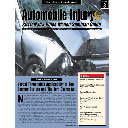Evan Torgan

August 26, 2013 | New York Law Journal
Summation: More Than a Final ArgumentIn their Trial Advocacy column, Ben Rubinowitz of Gair, Gair, Conason, Steigman, Mackauf, Bloom & Rubinowitz and Evan Torgan of Torgan & Cooper write: Summation marks the attorney's final interaction with the jury before the verdict is returned. However, it is one of the first things that an attorney should think about when meeting with a client for the first time.
By Ben Rubinowitz and Evan Torgan
11 minute read
January 09, 2013 | New York Law Journal
Trying a Labor Law Case With a Sole Proximate Cause DefenseIn their Trial Advocacy column, Ben Rubinowitz, a partner at Gair, Gair, Conason, Steigman, Mackauf, Bloom & Rubinowitz, and Evan Torgan, a member of Torgan & Cooper, write: While Labor Law Section 240 was written to protect workers in dangerous occupations at all costs - even from themselves - it has instead become a statute giving rise to the recalcitrant worker/sole proximate cause defense, allowing for many more defense verdicts. While Labor Law cases still provide a strong basis for statutory liability, they must be tried more artfully and carefully than ever before.
By Evan Torgan and Ben Rubinowitz
16 minute read

May 29, 2008 | New York Law Journal
Trial AdvocacyBen Rubinowitz, a partner at Gair, Gair, Conason, Steigman & Mackauf. and Evan Torgan, a member of Torgan & Cooper, write that in any personal injury case, effective cross-examination is essential to win the battle of medical experts. However, many lawyers don't prepare their examination of the opposing expert until the night before the actual cross takes place. The well-prepared lawyer knows better - a winning cross is prepared months in advance of trial.
By Ben Rubinowitz and Evan Torgan
11 minute read

February 09, 2010 | New Jersey Law Journal
Dealing With Weaknesses and Maintaining CredibilityIn all cases, however, where you have legitimate concern that certain tangential facts can affect the verdict, we strongly advise getting them out there first. Despite the difficult nature of initiating the topic, often the effort will be rewarded with a favorable verdict.
By Ben Rubinowitz and Evan Torgan
8 minute read

February 28, 2011 | New York Law Journal
Using the Internet as a Tool for Cross-ExaminationIn their Trial Advocacy column, Ben Rubinowitz of Gair, Gair, Conason, Steigman, Mackauf, Bloom & Rubinowitz and Evan Torgan of Torgan & Cooper discuss how internet-savvy trial attorneys can gain an edge in the courtroom with the aide of social media web sites and clever interrogation.
By Ben Rubinowitz and Evan Torgan
10 minute read

July 31, 2008 | New York Law Journal
Trial AdvocacyBen Rubinowitz, a partner at Gair, Gair, Conason, Steigman & Mackauf, and Evan Torgan, a member of Torgan & Cooper, write that too often, trial lawyers use demonstrative exhibits only in the one part of the trial during which the exhibit is offered - usually direct examination. Although a strong point can be made during direct, with a good amount of planning and a little bit of creativity, that exhibit can serve to bolster your point throughout the entire trial and, more importantly, serve as your surrogate during the one part of the trial when you are not present - jury deliberations.
By Ben Rubinowitz and Evan Torgan
12 minute read

April 25, 2011 | New York Law Journal
Dealing With Damages in Voir Dire and SummationIn their Trial Advocacy column, Ben Rubinowitz, a partner at Gair, Gair, Conason, Steigman, Mackauf, Bloom & Rubinowitz, and Evan Torgan, a member of Torgan & Cooper, write that any victory in a personal injury case is a Pyrrhic one unless the plaintiff receives all the damages he is entitled to. So first, the trial lawyer must select a jury which does not enter the courtroom with a bias against large damages awards. At the end of the case, the skilled attorney must tie the proof in the case to the commitments obtained from the jurors in voir dire to follow the court's instructions on damages, wherever it may lead.
By Ben Rubinowitz and Evan Torgan
15 minute read
December 28, 2010 | New York Law Journal
Common Mistakes on Direct ExaminationIn their Trial Advocacy column, Ben Rubinowitz, a partner at Gair, Gair, Conason, Steigman, Mackauf, Bloom & Rubinowitz, and Evan Torgan, a member of Torgan & Cooper, advise on more effective questioning of witnesses, reminding attorneys to simplify legalese or medical jargon for the jury and emphasize essential points before moving on.
By Ben Rubinowitz and Evan Torgan
8 minute read
August 23, 2011 | New York Law Journal
Depositions: An Important Tool for TrialIn their Trial Advocacy column, Ben Rubinowitz, a partner at Gair, Gair, Conason, Steigman, Mackauf, Bloom & Rubinowitz, and Evan Torgan, a member of Torgan & Cooper, discuss balancing leading questions with open-ended ones, questioning witnesses who may not be available at trial, videotaping, using errata sheets to cast doubt, and more deposition rules and tactics that are pivotal to building a successful case.
By Ben Rubinowitz and Evan Torgan
12 minute read

July 26, 2007 | New York Law Journal
Trial AdvocacyBen Rubinowitz, a partner at Gair, Gair, Conason, Steigman & Mackauf and an adjunct professor of law at Hofstra and Cardozo schools of law, and Evan Torgan, a member of Torgan & Cooper, write that a cross-examiner must know exactly where he needs to be at the end of his questioning before starting it. To achieve this, many trial lawyers first focus on the summation they would like to give and create a cross with that in mind. An even better strategy would be to work backwards from the charge to the jury.
By Ben Rubinowitz and Evan Torgan
12 minute read
Trending Stories
- 1Gibson Dunn Sued By Crypto Client After Lateral Hire Causes Conflict of Interest
- 2Trump's Solicitor General Expected to 'Flip' Prelogar's Positions at Supreme Court
- 3Pharmacy Lawyers See Promise in NY Regulator's Curbs on PBM Industry
- 4Outgoing USPTO Director Kathi Vidal: ‘We All Want the Country to Be in a Better Place’
- 5Supreme Court Will Review Constitutionality Of FCC's Universal Service Fund
More from ALM
- Legal Speak at General Counsel Conference East 2024: Match Group's Katie Dugan & Herrick's Carol Goodman 1 minute read
- Legal Speak at General Counsel Conference East 2024: Eric Wall, Executive VP, Syllo 1 minute read
- Legal Speak at General Counsel Conference East 2024: Virginia Griffith, Director of Business Development at OutsideGC 1 minute read



